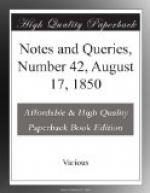“The taking away of warts, by rubbing them with somewhat that afterwards is put to waste and consume, is a common experiment; and I do apprehend it the rather, because of mine own experience. I had from my childhood a wart upon one of my fingers; afterwards, when I was about sixteen years old, being then at Paris, there grew upon both my hands a number of warts (at least an hundred), in a month’s space; the English Ambassador’s lady, who was a woman far from superstition, told me one day she would help me away with my warts; whereupon she got a piece of lard with the skin on, and rubbed the warts all over with the fat side, and amongst the rest, that wart which I had from my childhood; then she nailed the piece of lard with the fat towards the sun, upon a post of her chamber window, which was to the south. The success was, that within five weeks’ space all the warts went quite away, and that wart which I had so long endured for company; but at the rest I did little marvel, because they came in a short time and might go away in a short time again, but the going of that which had stayed so long doth yet stick with me. They say the like is done by rubbing of warts with a green elder stick, and then burying the stick to rot in muck.”
J.M.B.
* * * * *
MINOR NOTES.
Capture of Henry the Sixth.—At Waddington in Mytton stands a pile of building known as the “Old Hall,” once antique, but now much indeed despoiled of its beauty, where for some time the unfortunate king, Henry the Sixth, was concealed after the fatal battle of Hexham, in Northumberland. Quietly seated one day at dinner, “in company with Dr. Manting, Dean of Windsor, Dr. Bedle, and one Ellarton,” his enemies came upon him by surprise, but he privately escaped by a back door, and fled to Brungerley stepping-stones (still partially visible in a wooden frame), where he was taken prisoner, “his legs tied together under the horse’s belly,” and thus disgracefully conveyed to the Tower in London. He was betrayed by one of the Talbots of Bashall Hall, who was then high-sheriff for the West Riding. This ancient house or hall is still in existence, but now entirely converted into a building for farming purposes: “Sic transit gloria mundi.” Near the village of Waddington, there is still to be seen a meadow known by the name of “King Henry’s Meadow.”
In Baker’s Chronicle, the capture of the king is described as having taken place “in Lincolnshire,” {182} but this is evidently incorrect; it is Waddington, in Mytton, West Yorkshire.
CLERICUS CRAVENSIS.
The New Temple (Vol. ii., p. 103.).—As your correspondent is interested in a question connected with the occupants of the New Temple at the beginning of the fourteenth century, I venture to state, at the hazard of its being of any use to him, that I have before me the transcript of a deed, dated at Canterbury, the 16th of July, 1293, by which two prebendaries of the church of York engage to pay to the Abbot of Newenham, in the county of Devon, the sum of 200 marks sterling, at the New Temple in London, in accordance with a bond entered into by them before G. de Thornton and others, the king’s justices.




